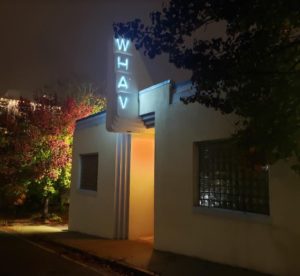
The WHAV call letters were first heard back in 1947. 75 years later, WHAV-FM is going home to the art deco-styled structure it was once housed in. Today’s WHAV—like the original station—broadcasts from the Silver Hill transmitter and tower site. Its studios, now in the Ward Hill section of Haverhill, Mass., are in the process of returning to the building at 30 How St. that still bears its name.
“WHAV is pleased and grateful to be joining WXRV—‘The River’—at the classic broadcast building that has long been associated with accurate, timely and reliable reporting and delivery of essential local news,” said President Tim Coco, whose news career began at WHAV more than 40 years ago. “Today’s WHAV is even more committed to original local news coverage as it is the last, Haverhill-based news source serving the nearly 70,000 people in its city of license.”
The two-story How Street building was designed by local architect Clinton F. Goodwin, who once said he was inspired by classic broadcast buildings. Goodwin relied on older examples as most new construction was halted during World War II. Initial station engineering was contracted to Frank H. McIntosh, who would develop the iconic McIntosh audio amplifier. The building was constructed by local contractor William H. Starbird.
WHAV’s main on-air studio will be in a room virtually unchanged by time with original built-in cabinetry and acoustic wall treatment, while the Edwin V. Johnson Newsroom moves to the building’s former Music Library. Both will be equipped, however, with the most modern and advanced furnishings and electronics for the finest quality, stereo sound.
While licensed under LPFM rules, today’s WHAV operates as a traditional, noncommercial educational broadcast station. It has worked with previous WHAV owners to continue the radio station’s legacy and maintain continuity.
At its formal rededication in 2017, descendants of WHAV founder John T. “Jack” Russ took part in the celebration and heard Russ’ voice for the very first time. It was part of a segment featuring Russ discussing the importance of local news.
“We in the newspaper business have followed radio closely. We have had to, because we know that broadcasting is closely linked with the job that a newspaper has to do—the dissemination of news and advertising and public service to the community and its business life. As time goes on, the vital part that radio plays in a progressive community will become more apparent,” Russ told the WHAV audience March 16, 1947.





